No products in the cart.
Maybe you have heard or not heard about this delicious fruit tree. But if you have not, then it is time to add Persimmon trees to your fruity collection.
Today we will look closer at this deciduous tree as you can find different types available. You can grow them in your backyard or find a dwarf Persimmon tree to grow in a container.
Plant Name: Diospyros spp.
Other Name: Persimmon Trees
Plant Type: Deciduous Tree
Native Areas: Asia and North America
Light Requirement: Full Sun to Partial Shade
Watering: Moderate
Fertilizer: Organic Compost or Manure
Toxicity: Non-toxic to pets, but the pip and seeds can cause blockage
Temperature: As low as 0° to -25° depending on the variety
Propagation: Cuttings and Grafting
Growth: 23 feet tall
Soil Type: Different Soil Types
USDA Zones: 4-9
More About Persimmon Trees

The Persimmon is a unique tree with vibrant orange fruit in fall and early winter. This outdoor tree belongs to the Diospyros family, which originates from China. The leaves begin to drop in winter.
Then, during late spring, you see pink-white flowers bloom, and the foliage has a blue-green hue.
The Persimmon fruit is ready to harvest in late fall, and the leaves transform to a yellow-orange color. You can find different Persimmon trees reaching up to 23 feet tall.
Still, you can find dwarf Persimmon trees to semi-dwarf varieties that remain small at 16 feet tall. Unfortunately, the Persimmon is slow to fruit, as with most fruit trees. Harvesting the fruit can take up to five years, but the wait is worth it.
Varieties of Persimmon Trees
In the Diospyros family, three types of Persimmon are grown commercially.
Diospyros kaki
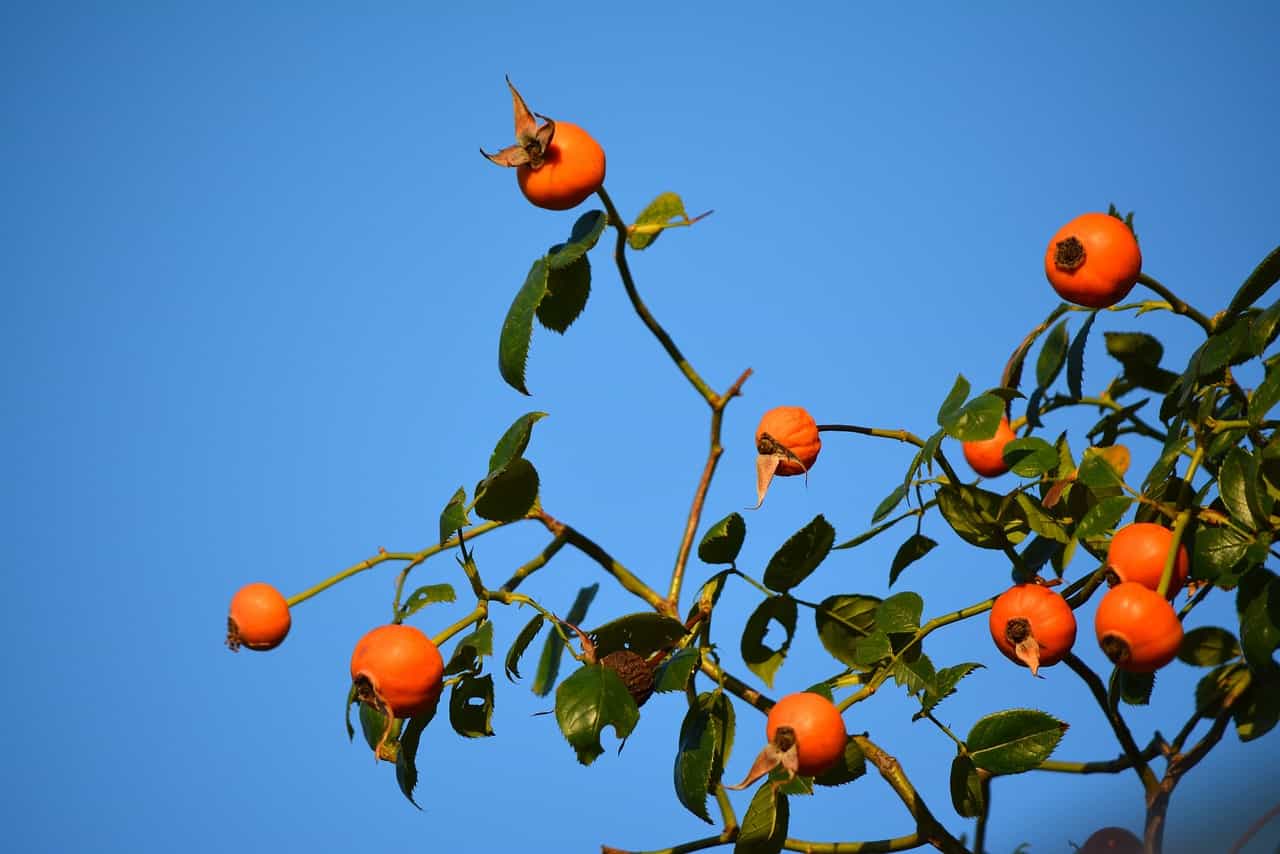
The Asian Persimmon native to China and Japan is the most common Persimmon cultivated. 80% of the world’s cultivation is the Asian variety from China. Still, it can be grown in most warm climates with common names Oriental or Japanese Persimmon.
Diospyros lotus
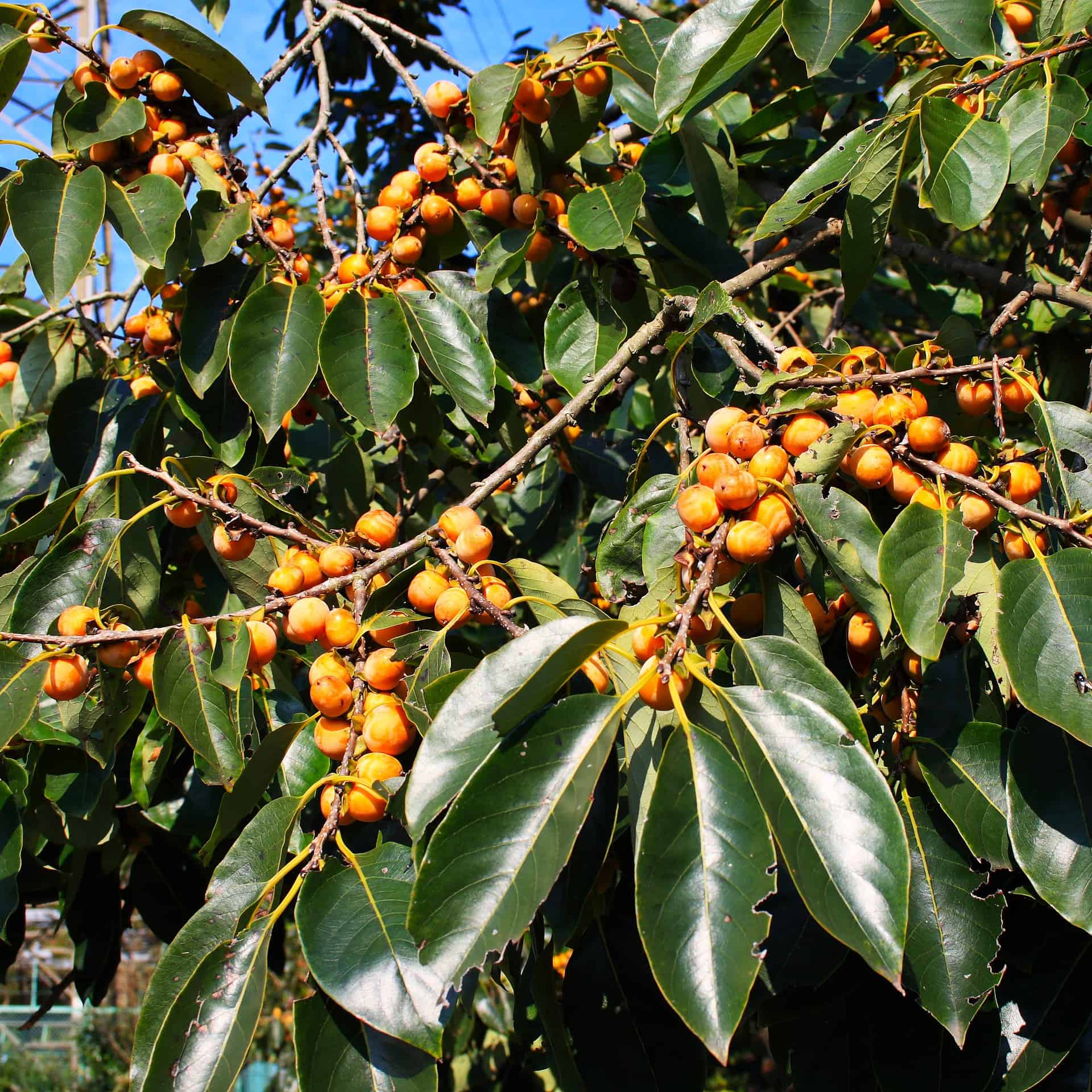
The Date Plum is native to Southwest Asia and Southeast Europe. It has small fruit that tastes like a mix of date and plum. You can also eat fresh but dry fruit, as it helps remove the tartiness taste.
Diospyros virginiana
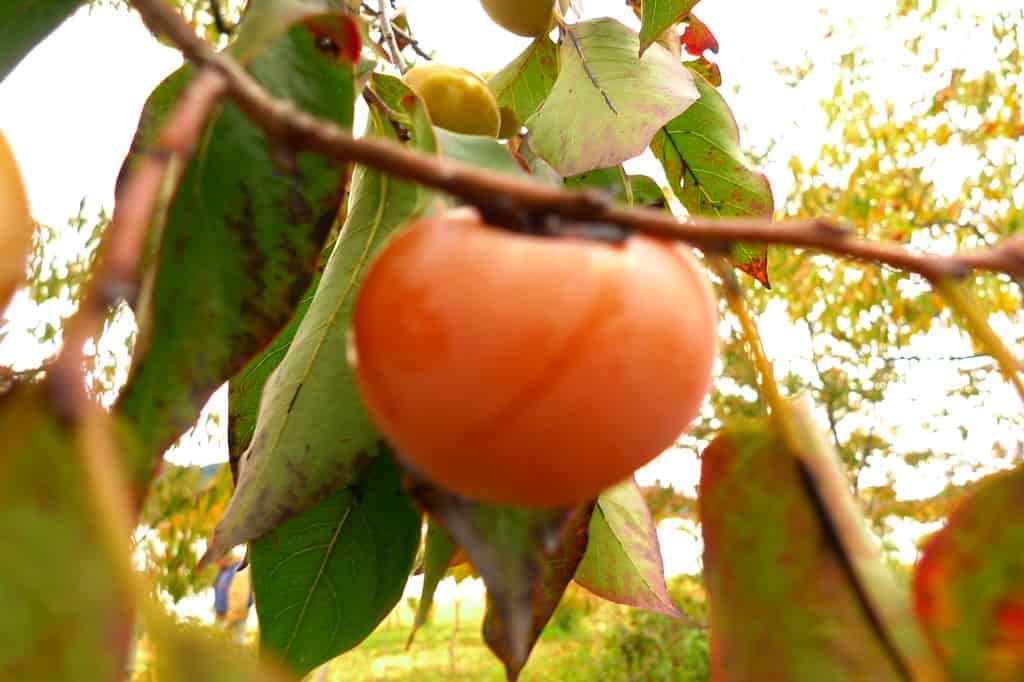 Diospyros virginiana @flickr
Diospyros virginiana @flickr
The American Persimmon, as you guessed, is native to Eastern North America. It is a cold hardy tree compared to the Asian Persimmons. The tree is cultivated commercially but remains popular to grow in the garden.
The Diospyros virginiana is classified as an astringent Persimmons and needs to be fully ripe before you can eat it.
The Main Difference Between These Fruit Trees
When choosing a Persimmon tree, you find two types, the non-astringent and astringent varieties. The astringent varieties of persimmon trees refer to the high presence of soluble tannins at maturity.
When eaten before the fruit is ripe, it can be very sour. Hence, you must leave the fruit to ripen and become soft. A popular variety is the Hachiya Persimmon tree. Yet, looking at the non-astringent types, the fruits lose the tannin content earlier.
You can safely eat fresh fruit from the tree, like an apple. A famous tree is the Fuyu variety. Some people refer to the astringent Persimmons as puckering and non-puckering for the non-astrigent type.
Still, in both fruit forms, they are delicious to eat in jellies, jams, salads, and more.
The Best Growing Conditions for Persimmon Tree
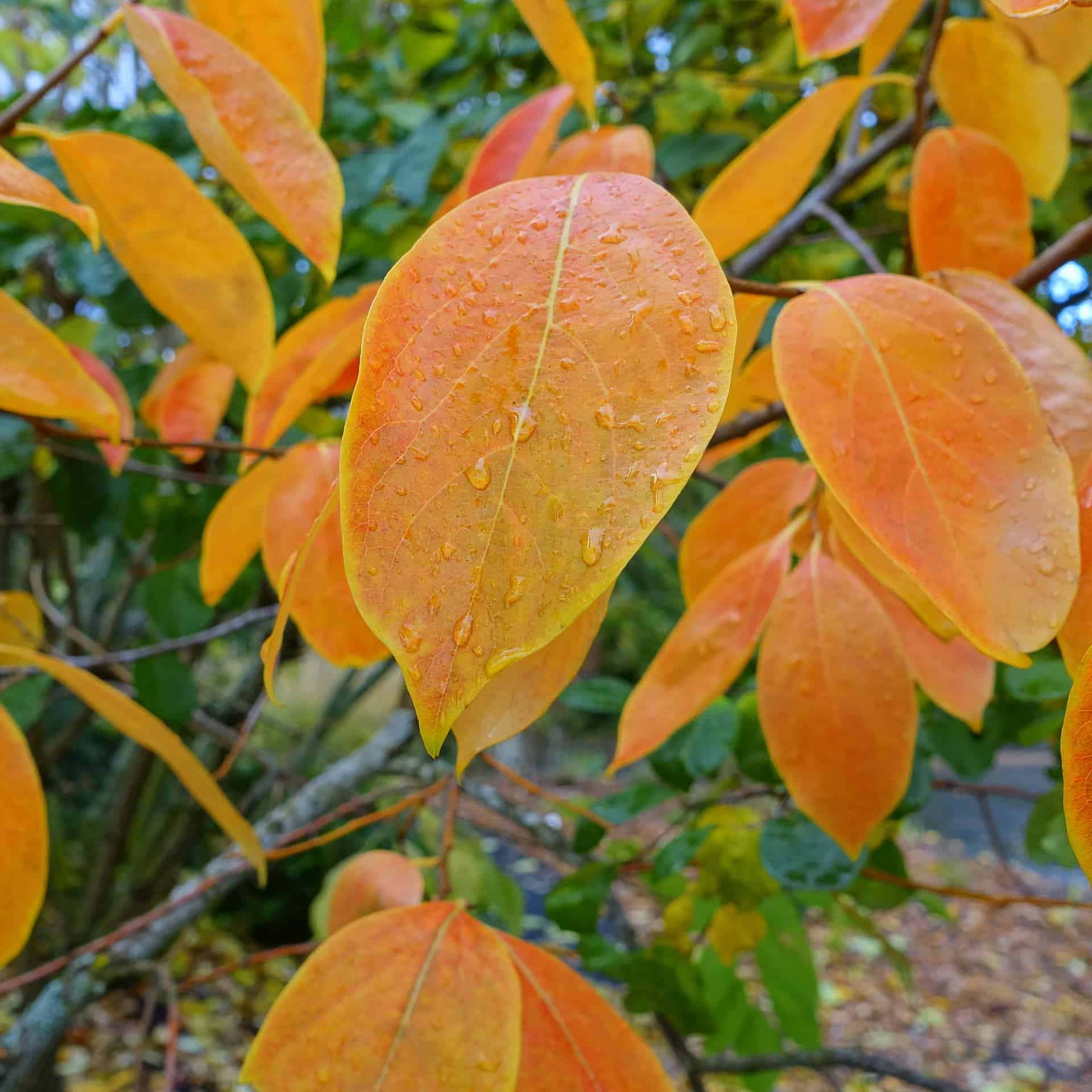
Whether you grow the non-astringent or astringent Persimmons, the care needs are the same, with some technicalities different.
Suitable Climate For Growing Persimmons
The Persimmon tree grows best in warm climates but is tolerant to cold weather. Your American Persimmons can tolerate temperatures down to -25° F (-31.5 °C). You can grow Persimmon trees from the Asian counterparts as low as 0° F (-18 °C).
Still, this tasty fruit variety prefers subtropical climates but does not do well in desert conditions.
The Best Soil For Persimmon
The astringent and non-astringent varieties thrive in loamy, well-drained soil filled with organic matter. Still, it is an easy-going tree when choosing the right soil type. We recommend opting for a pH level between 6.5 and 7.0.
If you have clay soil, you can amend it with compost and well-rotted manure a few weeks before planting your tree.
Suitable Lighting Needs When Growing Persimmon
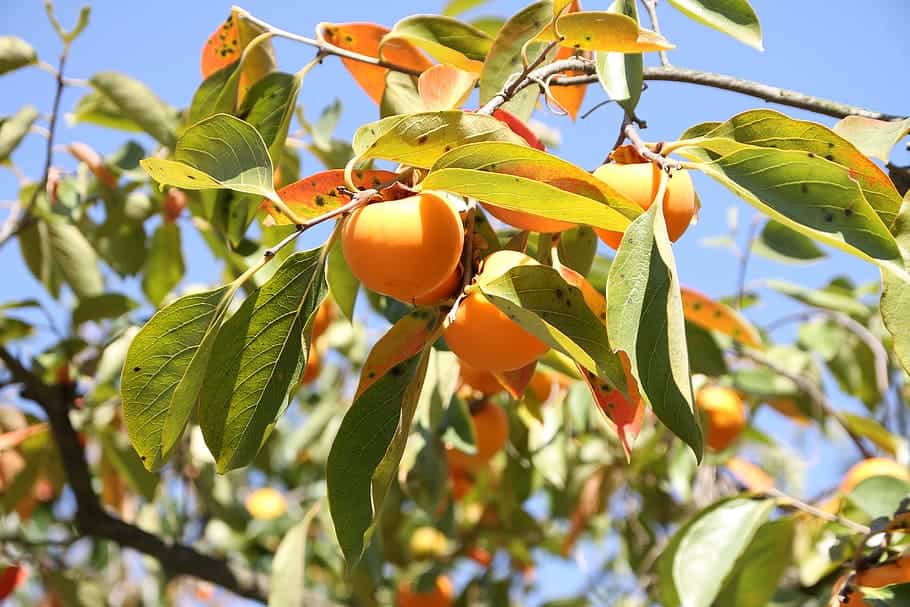
All varieties of Persimmons prefer at least six hours of direct sunlight with some shade in the afternoon. The important thing is to take the changing seasons and how the light affects your garden. So, if you want the best Persimmon fruit harvest, it needs enough sun throughout the year.
Watering Needs for Persimmon Trees
Young Persimmons need more watering than your mature tree. Furthermore, it also depends on the climate you live. If you have regular natural rainfall, deep watering once a week or twice in warmer weather is recommended.
For the dwarf Persimmon tree in a large pot, you will need to provide more watering.
Feeding Persimmon Trees
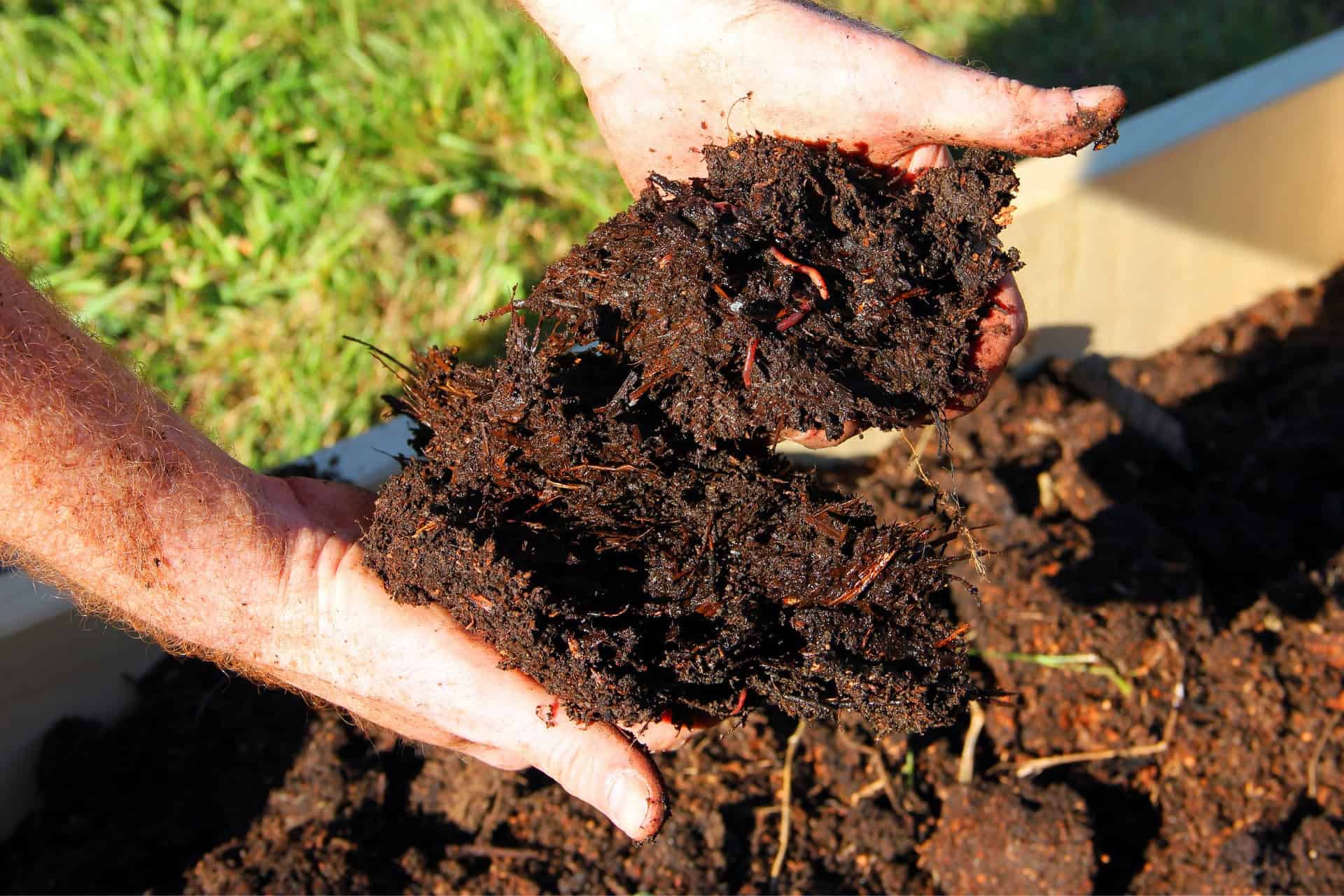
For proper care, as with enough sun and water, your trees will need some fertilizer but not much. We recommend using organic compost or aged manure to feed the soil, keeping it fertile.
The best is to monitor the tree’s growth to see if you need to add fertilizer. Some signs your tree can benefit from fertilizer are pale leaves or stunted growth. Your healthy Persimmon trees will have dark green foliage with a growth rate of one foot per year.
You can use organic fertilizer in early spring when the buds form as an added feed. Also, add some mulch around the tree trunk at the base to retain moisture and protect the roots. But keep the mulch away from the tree trunk as it can lead to rot.
Pruning Persimmon Trees
This task is essential for tree care and helps form a solid main trunk or multiple trunks. Then, you can give your young Persimmon a light pruning at the end of winter. Furthermore, it will help strengthen the branches to prevent breakage.
For mature Persimmons, you can remove dead branches to help encourage growth. You will find the flowers bloom on the current season’s stems and prune after fruiting in done in late winter.
Steps To Plant Your Tree
When you grow the Persimmon fruit trees, you can do it in multiple ways. For example, you can use seed, cutting, or grafts. Still, the best method is via grafting, as the tree produces fruit true to the variety you want to grow.
Hence, you find them as young grafted trees or bare root trees. You can easily transplant them to the location in your yard where you want them to grow. The best time to plant your Persimmon is in winter, during the dormant season, to help prevent transplant shock.
Find a sunny spot in the yard at least 13 feet away from other outdoor plants and trees. Try to find a place that does not get too much wind.
Dig your planting hole bigger than the container you received your Persimmon in. Add water to the hole but do not fertilize, as it can burn the roots.
Place the Persimmon at the same level as in the pot and backfill it with soil and water.
Add your compost and organic matter to help get your Persimmon off on the right start for growth.
Water regularly while your Persimmon settles in and reduces after a year of growth.
Propagating Persimmon
Grafting is for the more advanced gardener, but it does not mean a beginner cannot try it. The process works for your astringent and non-astringent Persimmons.
All you will do is take a piece of your Persimmon and fuse it to another one. It will comprise the rootstock that is the bottom half of your Persimmon to form roots and the scion, a clipping of a fruit plant to help determine the type of fruit you grow.
So, if you want to give it a try, here are some steps:
During the dormant winter period, you can snip off a six-inch cutting from the tree branches known as the scion. The piece of wood should have three buds on it.
Wrap the cut end in a damp paper towel to store in a zip-lock bag. Ensure that all the air is removed before closing the bag. Keep the scion in your refrigerator until spring arrives.
Still, keep checking your scion to see that it does not mold, and clean it off. If it does, use 10% bleach and 90% water.
Now get a healthy young tree with a trunk diameter of four inches. Trim the tree to have one singular trunk standing three feet high.
Now make a two inches deep cleft in the trunk to wedge your scion.
Then take some grafting tape to wrap around the trunk and scion.
Take care of your sapling to monitor new growth as the two pieces fuse to form a new Persimmon.
Note: When it comes to Persimmon pollination, it can vary from one variety to another. The majority of Persimmons have either male or female flowers. Hence, the female flower needs pollination to bear fruit.
But you can find some species with both the female and male flower present, which is self-pollinating. For example, your American Persimmons are not self-pollinating; you will need a second one to help with pollination.
Both the Hachiya and Fuyu are self-fertile. Thus, it does not need another Persimmon to pollinate.
Common Pests and Diseases
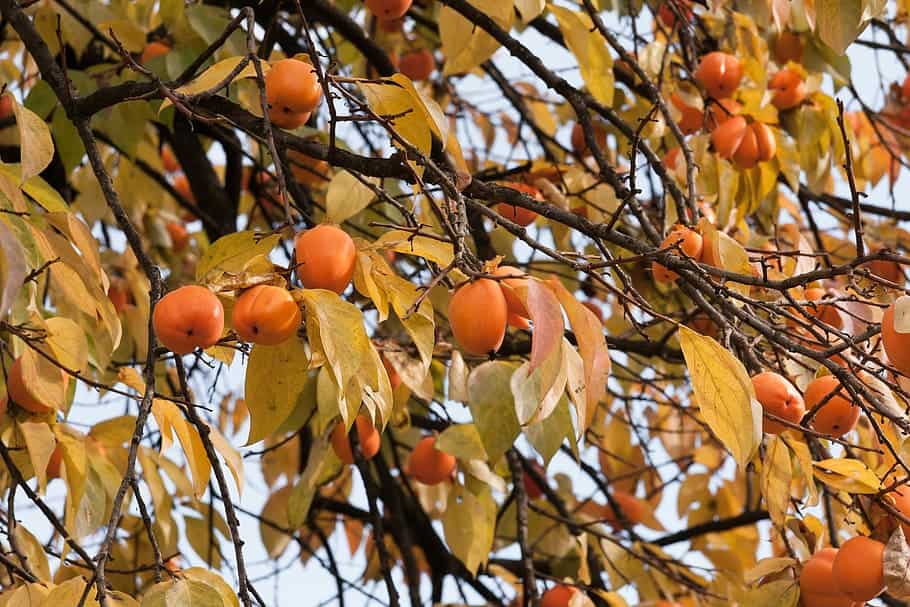
The Persimmon is hardy when established but can still be a home to pests and diseases.
Fruit flies are a problem as they can become serious pests. The fruit will have tiny black spots, and using exclusion bags to cover your Persimmon after flowering help.
Mealybugs are detrimental to a Persimmon plant, and you can use organic spray soaps to control them. Another concern is that these bugs leave sticky trails, leading to ants, and dish soap helps.
Common diseases are leaf spots which are tiny brown spots on the leaves. While galls can grow on the roots and crown, you can also have a calyx separation. The disorder causes a cavity under the calyx resulting from too much nitrogen.
Frequently Asked Questions
It is crucial to harvest the astringent varieties when the fruits are ripe. Alternatively, you can pick the fruits and let them ripen in the kitchen in a bowl with a banana or apple.
For the non-astringent Persimmons, you can eat them off the trees. When picked and left to ripen further, they become sweet. The best way to know if the fruit is ripe is when it turns from green to orange or yellow.
You can store the fruit at room temperature until ripe and soft. Then you can place the fruit in the fridge to help extend the shelf life to two weeks. You can keep them in a freezer for up to a year, but a whole frozen fruit lasts only a few months as the flavor to texture deteriorates.
Persimmons are great in fall recipes to enjoy the sweet flavor, especially in jams on toast.
You can find the Persimmon trees sold at your local nursery or Plantly. So, you can choose your variety to enjoy the edible fruit from the trees. These tasty fruits are great for heart health as they are nutritious.
Whether you want to buy, sell, or simply reach out to other plant enthusiasts, Plantly is the right place to be!


